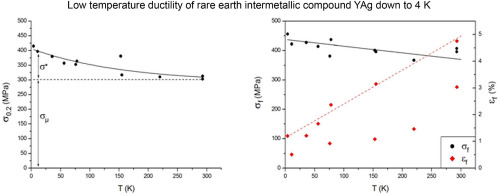Deformation mechanisms of nil temperature ductile polycrystalline B2 intermetallic compound YAg
Rolf Schaarschuch, Carl-Georg Oertel, Guanghui Cao, Jens Freudenberger, Heinz-Günther Brokmeier, Werner Skrotzki
Index: 10.1016/j.actamat.2018.03.064
Full Text: HTML
Abstract

The most ductile rare earth intermetallic compound, YAg, was subjected to an thermal activation analysis at low temperatures down to 4 K. Evaluation of the activation parameters and their dependence on stress and temperature yields strong indication for forest dislocation cutting as the rate-controlling deformation mechanism, similar to face-centered cubic metals. Surprisingly, nil temperature ductility was observed. Together with results of a detailed TEM analysis of the active slip systems it is concluded that, despite of violating the von Mises criterion for the plastic deformation of polycrystalline materials, a low elastic anisotropy and/or low Peierls stress is responsible for the appreciable ductility at low temperatures. This finding may help to search for other ductile systems in the broad class of intermetallic compounds.
|
Compositional effect on microstructure and properties of NbT...
2018-04-04 [10.1016/j.actamat.2018.03.065] |
|
High resolution transmission electron microscopy correlated ...
2018-04-04 [10.1016/j.actamat.2018.03.066] |
|
Effect of heat treatment on the microstructural evolution of...
2018-04-04 [10.1016/j.actamat.2018.03.017] |
|
Fatigue deformation in a polycrystalline nickel base superal...
2018-04-03 [10.1016/j.actamat.2018.03.035] |
|
Grain boundary properties of a nickel-based superalloy: Char...
2018-04-02 [10.1016/j.actamat.2018.03.059] |